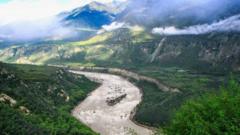The Yarlung Tsangpo dam, set to outproduce the existing Three Gorges Dam, has ignited fears among rights groups about the potential displacement of Tibetan communities and ecological degradation across India and Bangladesh. Chinese authorities assert it supports local prosperity and climate neutrality, despite historical uproar over similar projects.
China's Ambitious Yarlung Tsangpo Dam Project Raises Environmental and Human Rights Concerns

China's Ambitious Yarlung Tsangpo Dam Project Raises Environmental and Human Rights Concerns
China greenlights the construction of the world's largest hydropower dam in Tibet, heightening tensions over environmental repercussions and community displacements.
Concerns are growing as China embarks on the world’s largest hydropower dam development in Tibet's Yarlung Tsangpo river, projecting a threefold energy output compared to its previous major dam, the Three Gorges. State media praises the project for its potential to generate economic growth and aid China's carbon neutrality goals. However, critics argue that it threatens to displace significant local populations and devastate one of the most biodiverse ecosystems on the Tibetan Plateau.
The development has reignited sentiments similar to past protests against Chinese projects in Tibet that often ended in violent crackdowns. Experts predict that any sizeable alterations to the river could impede flow to downstream countries, particularly India and Bangladesh, fostering geopolitical tensions. The new dam's construction necessitates extensive tunneling through precarious terrain—a move that raises strong alarms over increased instability in an already earthquake-prone region.
Additionally, while Beijing claims adequate relocation efforts, the historical context shows that similar initiatives have led to widespread dislocation. Reports suggest the dam's completion, costing an estimated $127 billion, could necessitate displacing thousands, further complicating the livelihoods of the local Tibetan community amid fears of extensive ecological disruption.
Despite reassurances from authorities of minimal environmental impacts, the project has garnered backlash over its historical legacy of exploitation in Tibet in a region marked by strict political control and chilling human rights records. With increasing scrutiny, the implications of the Yarlung Tsangpo dam will likely ripple far beyond Tibet, shaping the future of water control in an interdependent Asia.
The development has reignited sentiments similar to past protests against Chinese projects in Tibet that often ended in violent crackdowns. Experts predict that any sizeable alterations to the river could impede flow to downstream countries, particularly India and Bangladesh, fostering geopolitical tensions. The new dam's construction necessitates extensive tunneling through precarious terrain—a move that raises strong alarms over increased instability in an already earthquake-prone region.
Additionally, while Beijing claims adequate relocation efforts, the historical context shows that similar initiatives have led to widespread dislocation. Reports suggest the dam's completion, costing an estimated $127 billion, could necessitate displacing thousands, further complicating the livelihoods of the local Tibetan community amid fears of extensive ecological disruption.
Despite reassurances from authorities of minimal environmental impacts, the project has garnered backlash over its historical legacy of exploitation in Tibet in a region marked by strict political control and chilling human rights records. With increasing scrutiny, the implications of the Yarlung Tsangpo dam will likely ripple far beyond Tibet, shaping the future of water control in an interdependent Asia.




















